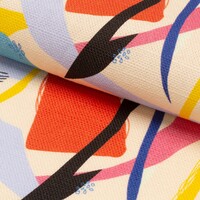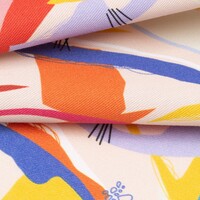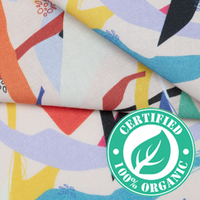Patchwork Fabric
Patchwork Upholstery Fabric
from €23.98
Create your own beautiful patchwork piece with our selection of patchwork fabric, printed with your own ph...
Read MoreShips in 1 - 2 days
Delivery: €9.95
Handmade item
Create your own beautiful patchwork piece with our selection of patchwork fabric, printed with your own ph...
Read MoreShips in 1 - 2 days
Delivery: €9.95
Handmade item
When creating a patchwork piece, non-stretch fabrics are favoured; this is because it makes it much easier to stitch all the pieces together, and to ensure that your larger design is adhered to by the smaller pieces.
Browse our range of patchwork fabrics
Medium weight, silky and non-stretch with a shiny finish, smooth and opaque, perfect for quilting
100% polyester
Medium weight, soft and non-stretch with a matte finish, smooth and opaque and great for quilting
84% cotton / 16% poly
Medium weight, soft and non-stretch, matte and opaque, great for quilting
95% cotton 5% linen
Medium weight, soft and non-stretch with a matte finish, opaque and ideal for quilting
100% cotton
Medium weight, soft and non-stretch, coarse with a matte finish, semi transparent and great for quilting
100% cotton
Care instructions
Wash at 30°c, low tumble dry heat, hang to dry, do not wring, low heat iron.




Patchwork is a pieced work, which is done by sewing different pieces of fabric together into a bigger design. The larger design can be a very simple pattern, using squares of an equal size and shape, in a repetitive pattern, however this is not always the case. Some patchwork pieces are made up of different sized and shaped pieces of fabric; geometric shapes are easier to piece together, but you have full creative freedoms to create whatever sized or shaped pieces you like. Historically patchwork pieces used up all the scraps of other fabrics, and can be dated back as far as 5000 years ago, being found in Egyptian tombs and early age China. During the Great Depression, patchwork had a widespread revival, to recycle worn clothing into warm quilts. Patchwork quilts tend to use the patchwork piece as the top layer, with a layer of wadding and and a bottom backing layer. Patchwork pieces can be used to create cushions, bags, wall hangings, patchwork upholstery fabric and even jackets.
We print your patchwork material by the yard or metre, in bespoke sizes chosen by you. The patchwork fabric is then digitally printed with your design using one of our expert printing methods. Natural fabrics tend to use pigment printing techniques, applying coloured dyes directly to the fabric in a localised area to build up your custom design. Synthetic fabrics favour our dye sublimation process, printing your personalised design onto a transfer paper, and then with heat, bonding this to the fabric.
You can choose to have your patchwork upholstery fabric hemmed, with either an overlock or baby hem, in either black or white thread. As your patchwork material will likely be stitched together with other patchwork fabrics, you might prefer to have it either cut on the line with all white edges removed, or sent as it comes directly from the printer, with your
All of our fabrics are printed at 200dpi. This works for us as it combines a great quality as well as a good file weight. In order to avoid resizing and interpolation, we recommend that you scale your image to 100% at 200dpi. Our design interface works with a traffic light system that acts as a quality marker for your designs. This will show you whether the resolution is too low for printing. When you re-upload your design with
Your uploaded design will automatically be scaled to fit the size of
We always recommend using an RGB colour space when you upload your images. More specifically, we suggest using the sRGB image profile, to achieve
There is no length limit for most of our fabrics. Our preview design window is set up to display a maximum of 10m to help you visualise the print, but that doesn't mean this is the print limit. If you'd like to order more, you can increase the quantity (x2 for 20m or x4 for 40m for example) and order as much as you'd like. Larger volumes will receive an automatic discount too. While the fabric length is nothing to worry about, each individual fabric will have a maximum width side: these can be found on the fabric's page information or in the design interface.
Yes, that will help you when it comes to cutting or framing your printed fabric. We recommend always adding a little extra space for borders into your purchased fabric size. When we print your
Crocking is the term used to describe fading along the creases in
Yes, our organic fabrics don't have an additional coating like non-organic fabrics have, which means it absorbs the inks deep into its fibre and reducing the colour strength slightly (this can be approximately -40%). If you would like a bolder, more vibrant colour for your fabric, we would suggest using a non-organic fabric.
Unfortunately not; all of our fabrics have been tested meticulously to ensure we know exactly how to get the best results, and our facilities cater perfectly to them. If you are set on a fabric we don't offer, we can offer custom printed sublimation paper to order which will allow you to heat press your designs onto your own fabrics.
If your design is simple and less intricate, a JPEG will be absolutely fine. However, if you have created a design with multi-coloured detailing, we would recommend saving your design in a TIFF format.
Similar to other fabric printing processes, shrinkage can occur. The amount of shrinkage will depend on the fabric, but as a general rule of thumb, please allow for 2-8% shrinkage when working out your measurements. Shrinkage is not an exact science, and the amount of shrinkage will vary from print run to print run. We'd always suggest ordering a little more than you need for your project.
Many of the fabrics we offer are semi-transparent, so printing on both sides of the fabric is not a service we offer.
At the moment, all of our fabric labels are printed on satin fabric. For now, we believe this is the best choice, but will potentially introduce other options in the future. All labels are cut to the same label format. If you would like to choose a different fabric and format for your labels, you could always order a sheet of the fabric of your choice to create labels yourself.
Our fabrics are printed with water-based inks as environmental consciousness is
Although very rare, there could be a slight colour difference from one print run to another. This is a normal part of the printing process,
Our full cut & sew service at Bags of Love can be used to your full advantage. We even offer hemming for your fabrics at a small additional cost. Our hems are created with a one or two cold hem that typically uses around 5 to 20mm of fabric (depending on the thickness of your chosen material). Please bear this in mind when you are ordering your printed fabric with hems: If you would like your finished piece to be 100cm x 100cm, change your dimensions to 101.5cm instead to allow space for your hems (you will also need to include additional for potential shrinkage). The thicker the fabric, the bigger the hem will be. Your printed fabric will be hemmed with either Black or White thread. If you are ordering a lightly woven material or
For further information about our fabrics see our FAQs.
Please note: As everything we provide is handmade to order, you may find a slight variance in the sizes.









